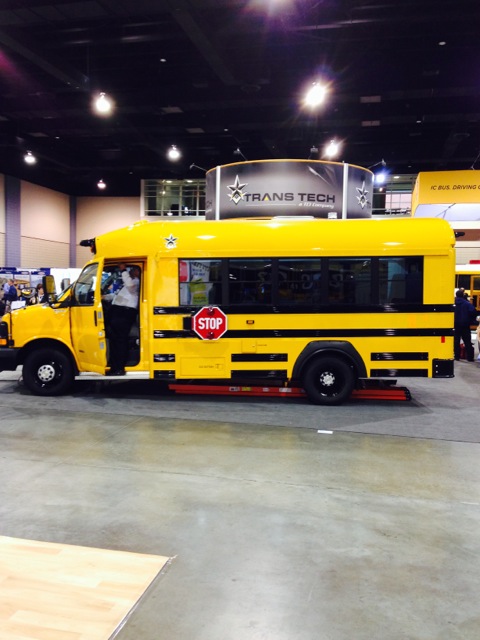As technician candidates, we learn that children on large school buses are protected by compartmentalization, but when the bus is small, seat belts are required to protect occupants properly. We’re also taught that the cutoff between small and large buses is a 10,000-pound gross vehicle weight rating (GVWR).
But have you looked at school buses lately? Over the past several decades, bus manufacturers have introduced new size options to meet the various needs of student transporters. Thus, there are many buses in use that one might consider “small,” but in fact weigh just slightly more than the 10,000-pound maximum GVW required to be deemed small.
This wasn’t the case in 1977, when NHTSA first introduced standards for school bus seating (included in FMVSS 208, 210, and, especially FMVSS 222, which covers compartmentalization). Back then, existing buses were one of two, clear-cut types: the traditional large yellow bus and the small, van-based bus for special applications. These two types had distinctly different weights, with large buses having a typical GVWR of over 21,500 pounds (most of them at least five times the weight of an average passenger vehicle) and small buses weighing 10,000 pounds or less.
The small buses of the 1970s were built on a cutaway van chassis, and the ones made today are as well. However, while all van-based school buses in the ‘70s had a GVWR of less than 10,000 pounds, most of those made today weigh between 10,000 and 14,500 pounds. Ford and GM, the two manufacturers that make chassis for van-based school buses, offer only four model options that are rated 10,000 pounds or less, but nine options rated between 10,001 and 14,500 pounds. Of those nine van-based chassis rated between 10,001 and 14,500 pounds, three weigh less than 10,101 pounds. These van-based buses look small because they are small—but they are not required to have seat belts to protect occupants because they technically meet the weight-based requirements to be called a large bus. Because of these “larger small” bus options, buses required by FMVSS 222 to have seat belts make up only 22 percent of van-based bus purchases and comprise merely 5 percent of the total school bus market.
Regardless of where you stand on the debate about whether or not full-size school buses should have seat belts, it is indisputable that buses made from cutaway vans have structure and handling characteristics that are similar to most passenger cars and light trucks, and therefore seat belts are warranted, just as they are in those vehicles. So, applying the standard as written back in the 1970s to determine whether or not a bus made today is small is dangerously out of sync with the spirit of the original regulation. What should distinguish a small bus is that it is built on a cutaway van frame, not that it has a certain weight. In addition to experiencing higher crash loads than a large bus, van-based vehicles have a higher center of gravity, shorter wheelbase, and narrower track that also increase their propensity to roll over.
This seems like something that would be easy to fix, as NHTSA could simply respond to the changing times and update the definition of a small bus in applicable standards. In August, IMMI (the parent company of bus-seating maker SafeGuard) submitted a formal petitioned to ask NHTSA to do that by changing the definition of a small school bus to one with a 15,000 GVWR or less. But time will tell how, and if, NHTSA responds. In the past, NHTSA has shown a reluctance to address this problem. For instance, in 2007, when NHTSA issued a Notice of Proposed Rulemaking announcing its intent to upgrade several school bus standards (which it ultimately did), several commenters (including all three of the national school bus industry associations) asked that NHTSA take that opportunity to revise the term “small bus” by extending it to all buses up to a 14,500-pound GVWR. However, NHTSA denied these requests without providing a thorough explanation, simply declaring that it was “outside the scope” of the rulemaking.
Ironically, in a 2011 denial to a petition that had asked NHTSA to require lap-shoulder belts in all seating positions of all school buses, NHTSA explained that: “Small school buses are different from large ones in that they are built on the same chassis and frame as a light truck and thereby have similar crash characteristics of a light truck.” Inexplicably, despite acknowledging that small school buses are different due to the chassis and frame, rather than a particular weight, NHTSA continues to lump many buses built on this framework in with large buses when it comes to regulations affecting child safety.
Sadly, in its 2007 denial to change the definition, NHTSA noted, “…the suggested change in weight limit is not trivial. Expanding the small school bus category as suggested would result in a substantial increase in the fleet percentage of small school buses, i.e., from 7.2 to 24 percent.” In its August petition, IMMI calls this attitude into question, pointing out that what should matter about a substantial increase in the number of buses that must have seat belts “is the increase in the number of students provided with enhanced lap-shoulder belt protection in crashes of school buses with crash characteristics like those of school buses currently defined as ‘small’ in FMVSSs.”
Let’s hope that this time NHTSA is more receptive to the overwhelming evidence on this issue and makes a decision that puts child safety first.


